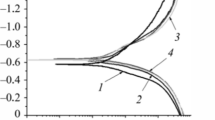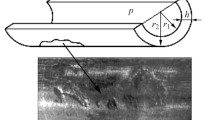A laboratory method has been developed to investigate the gaseous hydrogen effect on the intensity of electrochemical processes on pipe steels under the action of a model medium simulating condensate at the pipe’s inner surface. It is based on the measurement of electrochemical parameters of steel under conditions of gaseous hydrogen bubbling and simulates operating conditions when hydrogen saturates a thin layer of condensate inside the pipe. On the example of API 5L X70 pipe steel significant effect of hydrogen on its electrochemical behavior under such conditions is established. It is concluded that the saturation of the model medium with hydrogen significantly accelerates the corrosion of steel and its hydrogenation.




Similar content being viewed by others
References
D. Haeseldonckx, and W. D’haeseleer, “The use of the natural-gas pipeline infrastructure for hydrogen transport in a changing market structure,” Int. J. Hydrogen Energy, 32, Iss. 10–11, 1381–1386 (2007). https://doi.org/10.1016/j.ijhydene.2006.10.018
H. Vries, A. V. Mokhov, and H. V. Levinsky, “The impact of natural gas/hydrogen mixtures on the performance of end-use equipment: Interchangeability analysis for domestic appliances,” Appl. Energy, 208, 1007–1019 (2017). https://doi.org/10.1016/j.apenergy.2017.09.049
B. Meng, C. Gu, L. Zhang, C. Zhou, X. Li, Y. Zhao, J. Zheng, X. Chen, and Y. Han, “Hydrogen effects on X80 pipeline steel in high-pressure natural gas/hydrogen mixtures,” Int. J. Hydrogen Energy, 42, Is. 11, 7404–7412 (2017). https://doi.org/10.1016/j.ijhydene.2016.05.145
G. Pluvinage, L. Toth, and J. Capelle, “Effects of hydrogen addition on design, maintenance, and surveillance of gas networks,” Processes, 9, Is. 7, art. no. 1219 (2021). https://doi.org/10.3390/pr9071219
N. Sukurova, M. Wietschel, J. Fragoso Garcia, V. P. Müller, K. Franke, A. Kantel, M. Graf, E. Jalbout, N. Pieton, H. Abdel-Khalek, E. Bergup, and F. Weise, Ukrainian Hydrogen Export Potential: Opportunities and Challenges in the Light of the Ongoing War, HYPAT Working Paper 04/2023, Fraunhofer ISI, Karlsruhe (2023). https://doi.org/10.24406/publica-1398
A. Neacsa, C. N. Eparu, and D. Stoica, “Hydrogen–natural gas blending in distribution systems – An energy, economic, and environmental assessment,” Energies, 15, Is. 17, art. no. 6143 (2022). https://doi.org/10.3390/en15176143
H. Nykyforchyn, O. Zvirko, M. Hredil, H. Krechkovska O. Tsyrulnyk, O. Student, and L. Unigovskyi, “Methodology of hydrogen embrittlement study of long-term operated natural gas distribution pipeline steels caused by hydrogen transport,” Frattura ed Integrita Strutturale, 16, Is. 59, 396–404 (2022). https://doi.org/10.3221/IGF-ESIS.59.26
H. Nykyforchyn, O. Tsyrulnyk, O. Zvirko, and M. Hredil, “Role of hydrogen in operational degradation of pipeline steel,” Proc. Struct. Integrit., 28, 896–902 (2020). https://doi.org/10.1016/j.prostr.2020.11.060
O. T. Tsyrul’nyk, Z. V. Slobodyan, O. I. Zvirko, M. I. Hredil, H. M. Nykyforchyn, and G. Gabetta, “Influence of operation of X52 steel on corrosion processes in a model solution of gas condensate,” Mater. Sci., 44, No. 5, 619–629 (2008). https://doi.org/10.1007/s11003-009-9138-y
O. I. Zvirko, E. I. Kryzhanivskyi, H. M. Nykyforchyn, and H. V. Krechkovska, “Methods for the evaluation of corrosion-hydrogen degradation of steels of oil-and-gas pipelines,” Mater. Sci., 56, No. 5, 585–592 (2021). https://doi.org/10.1007/s11003-021-00468-8
M. Singer, “Top-of-the-line corrosion,” in: Trends in Oil and Gas Corrosion Research and Technologies: Production and Transmission, 385–408 (2017). https://doi.org/10.1016/B978-0-08-101105-8.00016-4
M. Seiersten, A. Dugstad, J. Nossen, and O. Sendstadm, “Top of line corrosion in gas-condensate pipelines,” IOP Conf. Ser.: Mater. Sci. Eng., 1201, art. no. 012082 (2021). https://doi.org/10.1088/1757-899X/1201/1/012082
E. Ohaeri, U. Eduok, and J. Szpunar, “Hydrogen related degradation in pipeline steel: A review,” Int. J. Hydrogen Energy, 43, Is. 31, 14584–14617 (2018). https://doi.org/10.1016/j.ijhydene.2018.06.064
ASTM G59-97. Standard test method for conducting potentiodynamic polarization resistance measurements, West Conshohocken: ASTM International (2020).
S. D. Cramer and B. S. Covino, Jr., (Eds.), ASM Handbook: Corrosion: Fundamentals, Testing, and Protection, Vol. 13a, ASM Int. (2003). https://doi.org/10.31399/asm.hb.v13a.9781627081825
W. Li, R Cao, L. Xu, and L. Qiao, “The role of hydrogen in the corrosion and cracking of steels – a review,” Corros. Commun., 4, 23–32 (2021). https://doi.org/10.1016/j.corcom.2021.10.005
I. M. Dmytrakh, A. M. Syrotyuk, and R. L. Leshchak, “Specific features of electrochemical hydrogenation of low-alloy pipeline steel in a model solution of ground water,” Mater. Sci., 57, No. 2, 276–283 (2021). https://doi.org/10.1007/s11003-021-00542-1
A. Lasia, “Mechanism and kinetics of the hydrogen evolution reaction,” Int. J. Hydrogen Energy, 44, Is. 36, 19484–19518 (2019). https://doi.org/10.1016/j.ijhydene.2019.05.183
V. G. Gavriljuk, V. N. Shivanyuk, and J. Foct, “Diagnostic experimental results on the hydrogen embrittlement of austenitic steels,” Acta Mater., 51, 1293–1305 (2003). https://doi.org/10.1016/S1359-6454(02)00524-4
M. C. Li, and Y. F. Cheng, “Mechanistic investigation of hydrogen-enhanced anodic dissolution of X-70 pipe steel and its implication on near-neutral pH SCC of pipelines,” Electrochim. Acta, 52, 8111–8117 (2007). https://doi.org/10.1016/j.electacta.2007.07.015
I. M. Dmytrakh, A. M. Syrotyuk, and R. L. Leshchak, “Effect of preliminary hydrogenation–dehydrogenation of low-alloy steel on its ability to absorb electrochemical hydrogen,” Mater. Sci., 57, No. 3, 387–396 (2021). https://doi.org/10.1007/s11003-021-00553-y
L. Briottet, I. Moro, and P. Lemoine, “Quantifying the hydrogen embrittlement of pipeline steels for safety considerations,” Int. J. Hydrogen Energy, 37, Is. 22, 17616–17623 (2012). https://doi.org/10.1016/j.ijhydene.2012.05.143
Author information
Authors and Affiliations
Corresponding author
Additional information
from Fizyko-Khimichna Mekhanika Materialiv, Vol. 59, No. 5, 10–17, September–October, 2023.
Rights and permissions
Springer Nature or its licensor (e.g. a society or other partner) holds exclusive rights to this article under a publishing agreement with the author(s) or other rightsholder(s); author self-archiving of the accepted manuscript version of this article is solely governed by the terms of such publishing agreement and applicable law.
About this article
Cite this article
Zvirko, O.I., Hredil, M.I., Tsyrulnyk, O.T. et al. Method of Assessing the Influence of Gaseous Hydrogen on Corrosion and Hydrogenation of Steels. Mater Sci 59, 524–531 (2024). https://doi.org/10.1007/s11003-024-00807-5
Received:
Published:
Issue Date:
DOI: https://doi.org/10.1007/s11003-024-00807-5




